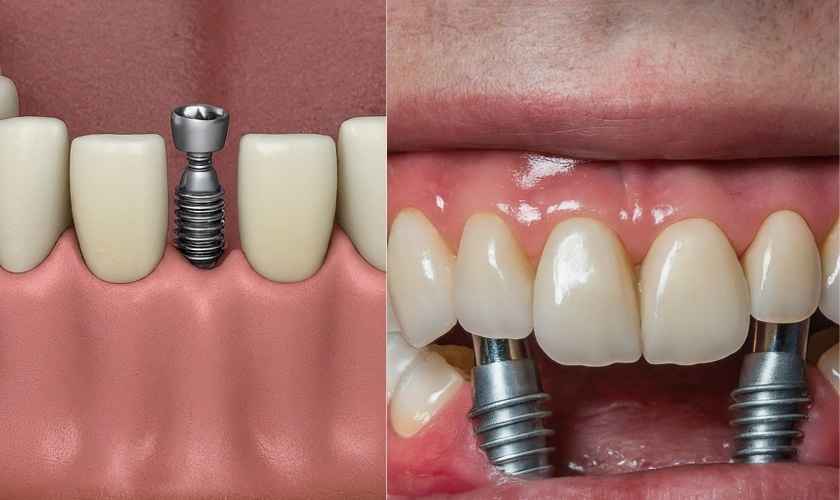Rumored Buzz on Dental Sense
Things about Dental Sense
Table of ContentsThe Buzz on Dental SenseSome Ideas on Dental Sense You Need To KnowThe 30-Second Trick For Dental SenseThe smart Trick of Dental Sense That Nobody is Discussing
are clinical devices surgically dental implanted right into the jaw to bring back a person's capacity to chew or their look. They offer assistance for artificial (phony) teeth, such as crowns, bridges, or dentures. When a tooth is shed because of injury or condition, an individual can experience complications such as rapid bone loss, defective speech, or changes to chewing patterns that result in pain.Oral implant systems consist of an oral implant body and dental implant joint and may additionally include an abutment fixation screw. Root canal procedure. The dental implant body is surgically put in the jawbone in location of the tooth's root. The oral implant abutment is typically affixed to the implant body by the abutment fixation screw and extends via gums right into the mouth to support the attached synthetic teeth
(https://fliphtml5.com/homepage/hegcy)Framework of The Oral Implant System selecting dental implants, speak with your oral company about the possible benefits and threats, and whether you are a prospect for the treatment. Points to take into consideration: Your general health is a crucial variable in establishing whether you are an excellent prospect for oral implants, how much time it will certainly take to heal, and the length of time the implant might stay in location.
Cigarette smoking might influence the recovery process and lower the long-lasting success of the implant. The recovery procedure for the implant body might take numerous months or longer, during which time you generally have a short-term joint instead of the tooth. the dental implant procedure: Carefully adhere to the dental hygiene instructions given to you by your oral copyright.
Not known Facts About Dental Sense
Implant failure can lead to the requirement for an additional operation to fix or change the implant system. Restores the capability to chew Restores aesthetic look Aids maintain the jawbone from diminishing as a result of bone loss Maintains the health and wellness of the surrounding bone and gum tissues Assists maintain adjacent (close-by) teeth steady Improves lifestyle Damages to surrounding all-natural teeth throughout dental implant placement Injury to the surrounding tissues throughout surgical procedure, such as sinus perforation Injury throughout surgery (for example, crack of bordering jawbone) Insufficient function, such as seeming like the teeth do not attack with each other normally A feeling that the tooth is loose or twisting in location arising from an abutment screw loosening Implant body failing (looseness of the implant body) because of systemic infection, which may be extra most likely in individuals with unchecked diabetes mellitus as a result of regional infection in bone and gum tissues sustaining the implant body due to delayed healing, which might be more probable in visit clients that smoke Trouble cleaning the periodontals around the dental implant, resulting in inadequate dental hygiene Without treatment gum illness Post-surgical feeling numb because of nerve impingement or damage Always inform health and wellness care carriers and imaging technicians that you have dental implants prior to any type of magnetic resonance imaging (MRI) or x-ray treatments.
FDA is not knowledgeable about any unfavorable occasions reported for MRI or x-ray procedures with dental implants. Oral implants systems are generally constructed from materials that adhere to global consensus standards of the International Organization for Standardization (ISO) or ASTM International. These criteria have information of what makes a risk-free material.

A dental implant is a framework that changes a missing out on tooth. With screw-like devices, the surgeon inserts an implant right into the jawbone, and it acts as an anchor for an artificial tooth, called a crown. A gadget called a joint connects the fabricated tooth to the oral implant. The crown is customized to fit the person's mouth and match the color of their teeth.
The Ultimate Guide To Dental Sense
Some individuals are not qualified for oral implant surgical treatment. It is for dental specialists to run on people with: severe illnessuncontrollable metabolic diseasebone or soft tissue disease or infectionIf these issues are settled, a person can have the surgical procedure. In, oral doctors avoid running on people with: If people with any of the above undergo dental implant surgical treatment, there is a higher risk of the implant failing.

Dental implant surgery is a personalized process. It's not the exact same for everybody. Yet the following offers a basic review of what you can expect your dentist, oral surgeon, periodontist or prosthodontist to do: Put the implant operatively. Provide you time to recover. Connect the message and last crown, bridge or denture.
Next, your doctor will carefully position the oral implant right into your jaw. If your implant is near the front of your mouth, your dental professional will make a short-lived tooth for you to use up until you recover.
7 Simple Techniques For Dental Sense
Throughout the recovery phase, your jawbone ought to fuse to the oral implant. This process can take anywhere from 3 to 9 months.
As soon as your implant heals, your dental expert can connect the joint (little adapter article) and your final repair (crown, bridge or denture). This normally takes about one hour to finish and may require a 2nd minor surgical procedure. You should not feel any type of discomfort throughout your oral implant treatment due to the fact that your company will utilize drug to numb your periodontals.